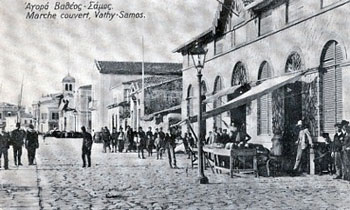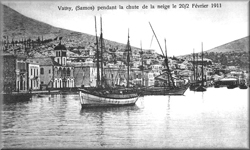| The
union with Greece changed the political and administrative system.
Samos had become a free Greek province. Naturally, the people’s
lives changed. The frequent communication with Asia Minor, where
Greek populations lived under the Ottoman rule, was reduced and
finally stopped in 1922. During the first World War, Greece
participated in the Entente alliance. From such position, it
managed to free the area of
Smyrna, but the Greek army |
|

|
|
|
|
lost by the Turks who forced nearly
all the Greek people of Asia Minor to leave at 1914. Approximately
1,500,000 Greeks came to Greece as refugees, abandoning their
ancestral lands where Greek populations lived for 3,000 years. The
largest wave of refugees was that of 1922, after the destruction
of Smirni, causing a sudden increase to the island’s population.
Many refugees settled permanently down at the island, in villages
and towns. Later, they built their own neighborhoods, called
“Prosfigika” (“The Refugees’ neighborhood”). Others
used Samos as an intermediary link to other places in Greece.
The
refugees that inhabited the island gave a different aspect to its
life, despite the difficulties they faced. They brought knowledge,
methods of land cultivation and a whole new culture with them.
They also provided a cheap work-force for the tobacco industries.
In the period between the wars, Samos tobacco and tanning industry
flourished. In 1934 the Union of Vinicultural Cooperatives of
Samos was established and within a short time it displaced the old
wine merchants. However, the tanning and tobacco industry stoped
soon after the second World War.
|
 |
 |
|